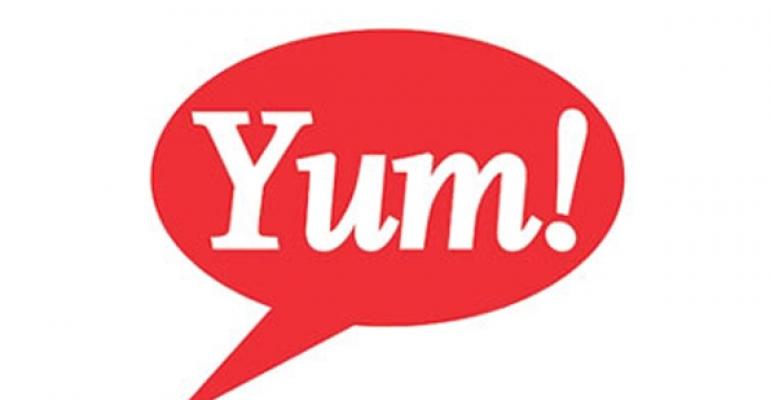Louisville, Ky.-based Yum! Brands Inc. has warned investors for the second time in two months that same-store sales will fall in the fourth quarter in its crucial China division, revising the expected decline down further on fallout from KFC China’s supply chain controversy.
In a statement released Monday Yum updated its expectations for the China division’s fourth-quarter same-store sales down to a 6-percent decrease from a previously forecasted 4-percent decline. The company said it lowered its guidance “due to adverse publicity associated with a government review of China poultry supply and the corresponding significant impact on KFC China sales during the last two weeks of December.”
RELATED
• Yum to step up growth in China and beyond
• Analyst bullish on Yum growth after Asia visit
• More restaurant industry finance news
Yum, which also is the parent to Pizza Hut and Taco Bell, derives about 40 percent of its operating profit from the fast-growing China region.
A long December
Yum previously released a same-store sales guidance for the fourth quarter on Nov. 29 after Chinese state television broke a story in mid-November that two chicken suppliers that had worked with KFC China allegedly used antibiotics and hormones to accelerate the growth of their chickens. That model said fourth-quarter same-store sales would decline about 4 percent in China.
According to securities analysts, Yum China stated publicly last year that the suppliers in question supplied a very small percentage of their total chicken purchases and that they had stopped procurement from those sources in August 2012. But the hit to KFC’s quality perceptions in China appeared to worsen in December, analysts noted, as Chinese regulators became more involved.
“In December,” analyst Andy Barish of Jefferies Equity Research wrote in a research note, “the Shanghai Food & Drug Administration then tested KFC samples, where it found that while KFC’s chicken was in compliance with safety standards, some samples did reveal high levels of an antibiotic, necessitating additional checks. In response, Yum publicly announced that it was cooperating fully with the authorities and noted a moderate impact to sales.”
Sales and traffic for KFC China decreased significantly as December wore on. In one research note, Jeff Farmer of Wells Fargo Securities estimated that Yum’s new guidance of a 6-percent decline in fourth-quarter same-store sales in China implies a 12-percent drop for the whole month of December. He and other observers speculated that trends were even harsher in the last two weeks of 2012, with comparable sales falling between 15 percent and 20 percent.
Farmer wrote that investors should not confuse the antibiotic-related headwinds with the challenges Yum already was facing in China from that country’s slowed growth, noting that Yum’s Nov. 29 guidance update came before the Shanghai FDA released the results of its findings. He added that Yum’s same-store sales growth in China has tracked closely with macroeconomic trends that are “lukewarm at best,” including an accelerating year-over-year change in Yuan deposits, a moderation in the China Wage Index, and decelerating year-over-year growth in disposable income.
Waiting out a media storm
Two other analysts covering Yum, David Tarantino of Robert W. Baird & Co. and Sara Senatore of Bernstein Research, wrote that Yum China ultimately could withstand the short-term decrease in sales if the chicken controversy blows over and the company gets to clarify its role in it.
“While negative media coverage of the chicken supply issues clouds the short-term outlook, particularly around high-volume Chinese New Year periods,” Tarantino wrote, “we are optimistic that KFC China will not see a long-lasting impact given the brand’s strong positioning with Chinese consumers and given Yum’s track record of successfully navigating through similar issues in the past.”
Tarantino was referring to a similar case of negative publicity for KFC China in 2005, when the chain was implicated in the Chinese food industry’s illegal use of a carcinogenic red dye.
Senatore wrote that the precedent from the controversy surrounding the red dye — which had existed in trace amounts in seasoning for two “New Orleans”-style chicken products — suggests that KFC China’s sales could similarly recover from a sharp negative turn as they did eight years ago.
“We view the current negative publicity as a near-term headwind that will ultimately subside,” she wrote. “We remain confident in Yum’s long-term growth trajectory. … The issue is negative publicity, not the integrity of Yum’s actual supply chain.”
But Bryan Elliott of Raymond James & Associates pointed out in another research note that the red dye situation in 2005, combined with an avian-flu scare soon after, contributed to four consecutive quarters of same-store sales declines. So far, authorities have held Yum back from a more vigorous defense of its supply chain practices, meaning the company could be running out of time to manage its public-relations problems, Elliott noted.
“We believe the company is awaiting clearance from the government before it is able to tell its story to the Chinese public,” he wrote. “We also suspect this clearance could be on hold until the closure of the government’s own investigation. If so, it could be some time before the company is able to meaningfully respond to the negative publicity.”
Including the more than 5,400 restaurants it has in China, Yum operates or franchises more than 38,000 outlets of KFC, Pizza Hut and Taco Bell in more than 120 countries and territories.
Contact Mark Brandau at [email protected]
Follow him on Twitter: @Mark_from_NRN




